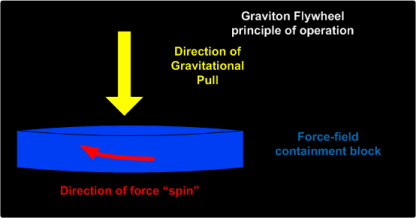Graviton Flywheel
Overview
The graviton flywheel is a 24th-century invention used to provide artificial gravity in space vessels and space stations.
History
Artificial gravity was experimented with in the technological boom years of the late-20th century, and a number of working devices were constructed. The technology was never reproducible on an industrial scale, however, until the early 24th century.
The breakthrough in artificial gravity generation came with the invention of the graviton flywheel. The technology was first deployed on the world-girdling network of Watchstation satellites, fully operational in 2324. Later developments allowed the technology to be applied to interplanetary space vessels.
Principles
The term "flywheel" is a misnomer, as the graviton flywheel does not employ a large spinning wheel. The metaphor is apt, however, as the principle of graviton flywheel operation is to store ambient gravitational energy and release it in a controlled manner.
Gravitational energy is stored in a field of force bound within a massive block of super-dense, super-conducting material. The energy requirements of maintaining the force field are considerable, requiring the output of a dedicated fusion reactor to operate a graviton flywheel.
The released gravitational energy causes a simulated gravitational pull "down" towards the flywheel as illustrated below.

The simulated gravity does not follow the typical inverse square law of gravity, instead falling off in a very short distance, as illustrated in this schematic of a Watchstation deck layout.

The graviton flywheel in a Watchstation occupies the very lowest level of the station, below the power deck. The dimensions of the force-containing block are 15m diameter by 2.5m high.
Due to the massive forces bound within the gravitation flywheel, turning off the artificial gravity is a lengthy and complex operation, requiring the controlled bleed of gravitons into space. If the wheel were forcibly stopped without following the "spin down" process, the resulting uncontrolled release of energy would be the destructive equivalent of a multi-megaton nuclear explosion.
Other Functions
A side function of the graviton flywheel is the ability to shift its position up or down a gravity well. In a space vessel, this greatly aids efficient landing and take-off operations. In the case of a geostationary Watchstation, it allows the station to speed up or slow down its orbit (by moving slightly closer to or further from the Earth) and so change the fixed point it orbits above.
Another function of the flywheel is to facilitate space-to-surface teleport operations. A study of the Watchstation teleport system is beyond the scope of this article, however.